|
SAUNDERS
ROE
Following
WW2,
Great Britain's world-class aircraft industry needed to extend its
engineering expertise by intensifying apprentice training programmes.
Within the great names of British aviation was the Saunders-Roe Company
who produced advanced aeroplanes from their base at Cowes on the Isle of
Wight. There, the apprenticeship scheme was extended and a residential
centre was established in order to attract candidates from the mainland.
The residential nature of the training
at Saunders-Roe engendered a 'college' culture, which, combined with the
innovative spirit, which prevailed at the time, created a very remarkable
environment for encouraging engineering achievement.
These engineers
dispersed all over the world and made a significant and valuable
contribution to aviation. Some of the names that were trained at the
Saunders-Roe Training College include former Chief Executive of GKN
Aerospace, Chris Gustar; and John Ackroyd, designer of Thrust
2, which
secured the world's land speed record.
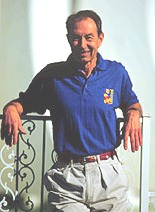
John
(Ackers) Ackroyd
The Company was
absorbed into Westland Aircraft in 1965 as part of the consolidation of the
British helicopter group. If you are an ex-apprentice of the Saunders-Roe
scheme, see this website: www.saroapprentices.co.uk
THRUST
2
Richard
Noble sold his TR6 car for cash to
fund his self built, crude THRUST1 jet car- the first pure jet car
designed and built in England. Thrust 1's first test run nearly killed him
when the car rolled. His wife, Sally, thought she had lost him forever.
But Richard was surprised that he did not panic and was determined to get
on and build Thrust2 as soon as possible. He then decided to place an
advert: "Wanted 650 mph car designer".
This advert found John
Ackroyd and by 1978 they started building the car. In 1980 Thrust2 created
6 new British records including the Flying Mile of 248.87 mph. Overcoming
various design, sponsor and location problems, Thrust2 eventually took the
world record averaging 633.468mph, with a peak speed of 650.88mph. This
record was held for 14 years, the second longest, for a land speed record,
of all time.
AUSSIE INVADER
Rosco McGlashen has just announced his intention to
go for the 900mph record. Currently the fastest Australian, with a
record of 642mph with the Aussie Invader 2, McGlashen is working a
deal with SpaceDev, the same company that was integral in the recently
successful SpaceShipOne shot last June. This image is of his concept car designed by John "Ackers" Ackroyd of the Isle of Wight.
Rosco
McGlashan is looking to drive the fastest car on Earth - strangely enough,
synthetic rubber and laughing gas could be the ticket.
After seeing X-Prize winner SpaceShipOne, McGlashan, "The fastest
Aussie on Earth," wondered if rocket motors could propel him up to
speeds of 1,609 km/h. So he called up SpaceDev, the company who provided
the rocket motor technology for the world's first
private-sector astronaut mission. He also enlisted the help of John "Ackers"
Ackroyd, the designer of 1983's land-speed-record-breaking car Thrust 2.
They came up a wingless rocket-powered jet fighter on wheels.
AUSSIE
INVADER . COM
AUSSIE
INVADER 2 (1989 - 1997)
- Current holder of the Australian Land
Speed Record set at Lake Gairdner SA
at 802 km/hr
- 18,000 lbs thrust
- 36,000 horsepower
- Max speed 608 mph
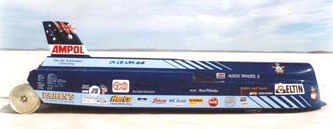
Aussie
Invader I
THRUST SSC
and THRUST 3
Ackroyd's
design for Thrust 3 - on the drawing board as part of the project from the
very earliest days - was shelved when Thrust 2 was deemed good enough to
get the job done. Whether or not it ever gets built will depend largely on
the efforts of Rosco McGlashan and Craig Breedlove with their jet cars.
Until then, sponsorship money is likely to stay very firmly in company
accounts.
After
Richard and John got the world record with Thrust 2, although they wanted
to build another car and looked at a number of ways of doing it. But they
were worried by a number of things. One was the question of what
actually happened underneath the car. They thought Thrust 2 could have gone
about Mach 0.1, (about seven miles / eleven km an hour) faster, before
the front of the car would start lifting. Obviously, the margin of
safety was too small at that speed.
John and
Richard kept talking, and kept seeing each other for a while
exchanging ideas, but it just wasn't going to gel. Then John had
to do some design work for Richard Branson's and the round the world balloon
project, leaving Thrust 3 in mid-air.
AUSSIE
INVADER WLSR ROCKET CAR
Aussie
Invader World Land Speed Challenge team headed by the 'Fastest Aussie on
Earth', Rosco McGlashan OAM, are building their new Land Speed Record
vehicle
featuring 300,000 horses of LOX / JP5 rocket power.
The
unique design by project engineers and designers Dr Ian Sutherland and
John Akroyd shows that Aussie Invader 5R (R for rocket) will be much
larger than the jet powered Aussie Invader 2 and 3 Land Speed Record
vehicles.
To
accommodate the fuel cells required it is being built at over 55 feet in
length
and almost 10 feet in tailfin height.
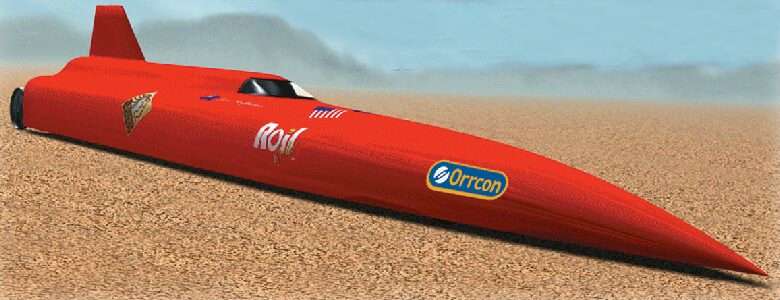
Aussie
Invader Rocket Car
BALLOON PROJECT INTERVIEW
NOVA: Tell us, John, what is your official title on this project?
ACKROYD: Well, I'm not a believer in titles. I'm a believer in
what people do. If I had a title, it would probably be
"Engineer."
NOVA: Okay. And what exactly as Engineer, are you doing on this
project?
ACKROYD: Well, engineering starts with—the real background for
the project starts with making the machinery, the flying machine. And
the next job is to launch the flying machine. And the third job is to
bring it and the people back safely.
NOVA: And you're involved in all three of those processes?
ACKROYD: Yes.
NOVA: Can you explain for us—What is a De Rozier system?
ACKROYD:
A De Rozier system is a mixture between a gas balloon and a hot air
balloon. In other words on a long flight, every day in the heat of the
sun, the gas expands, becomes comparatively lighter, and the balloon wants
to go up. Every night, the gas contracts, becomes comparatively more dense
and the balloon wants to go down. And the way to iron out these ups and
downs is to warm the air beneath the helium to gain extra lift at night.
And that is basically the De Rozier system. It's a very old system, used
by De Rozier, way back in the last century and, unfortunately, he used it
with hydrogen, which was all he had, and it was an explosive mix and poor
De Rozier became, I think, the first man to lose his life in a balloon.
But we use helium, which is a nice, inert, safe gas.
NOVA:
Is it a double balloon system, then?
ACKROYD: It is a compound balloon system. A double balloon system
would, perhaps apply more to the Earthwinds type of system, which had a
helium balloon on top and an air ballast balloon underneath. What we've
got is a helium balloon in a bottle over the top of a hot air cone and the
hot air cone heats the helium, which gives it extra lift at the cost of
fuel.
NOVA: And what do you mean, "at the cost of fuel"?
ACKROYD: Well, it means that to fly a De Rozier balloon, you have
to carry a penalty and that penalty is propane in our case, which heats
the air, which heats the helium, which keeps the balloon up.
NOVA: Which means that you will have a heavier payload?
ACKROYD: We're carrying a higher payload, yes. We're carrying fuel.
And that is what this test program we're now entering into is very much
about. How much fuel will we need to carry? How fast will we be burning
it? Will we have fuel left over that we can use for ballast? Will we burn
a bit out of each tank or will be burn a complete tank empty and drop it?
So that will give us the formula on how best to use our fuel. And, in
fact, we may be able to learn that we can use fuel for ballast as well as
lift. So it can work a double bonus.
NOVA: Do you think this system has a better chance of success than
Fossett's solo system? I understand he's using a De Rozier and there are
obviously different variables because he's flying solo and he's flying at
a lower altitude. From your perspective, which De Rozier has a better
chance?
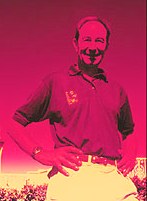
ACKROYD:
Well, really, the three major systems that are currently being
investigated—in fact, there's four—the De Rozier is one and this seems
the middle of the road system. It worked well on the Atlantic balloon
race. It seems at the moment to be the fashionable solution, though there
are other things around. One can use a super pressure balloon, which keeps
a constant pressure altitude, but if you burst that balloon, you're in big
trouble. And we saw an actual super pressure envelope burst with the
Earthwinds project, but, fortunately, that was a ballast balloon and not
the lift balloon. For a lift balloon to burst is a serious problem. So I
just hate the situation. So we're going with De Rozier, the same as Steve
Fossett.
The big difference between ours and Steve's is that he's going to fly a
low altitude attempt and we'll fly a higher jet stream altitude. There are
three altitudes which one could attempt this 'round the world. There's the
very, very high Odyssey-type balloon, which goes way up to 100,000
feet—fantastic height, and will then fly with jet streams or upper
altitude streams going in the opposite direction from jet stream flights,
which go from west to east. They would go in the opposite direction and
they would slowly descend, hopefully circling the world as they go. This
is a very extreme, innovative kind of attempt and to come back to ours,
it's the middle of the road. We will try to fly with the jet
stream. We've done it before, we've got a lot of experience in it and it
seems to me that that is the rapid fast way around the world. Above the
air in the fastest streams with the technology we already know.
Fossett's
is a low-altitude attempt and so he will be flying a simpler system and
simple is always good. He will have to use oxygen a lot more so it will be
uncomfortable and he will have to combat the weather, rather than fly
above it. And I think that will be very adventurous. I think he'll have a
lot of hard weather situations to get 'round, but he's a very determined,
accomplished, capable man and I wouldn't ever underestimate his ability to
go a long way at low altitude.
NOVA: What do you know of the fourth group?
ACKROYD: At the moment, there are no super pressure attempts that I
know of underway, really. Julian Knott was proposing one some time ago,
and in fact, he made a very long distance flight in Australia with one,
which was a pumpkin-shaped super pressure balloon. But it seems to have
died a bit of a natural death, maybe because of the high risk involved.
NOVA: What about the team that wants to launch out of the Swiss
Alps?
ACKROYD: That is the Piccard attempt, sponsored by the Swiss watch
maker, Breitling, and that is another De Rozier balloon and, as far as I
know, it's similar in concept to Steve Fossett's.
NOVA: Our mission, as you know, is science and technology. What
kinds of technical and educational background does one need to do what you
do?
ACKROYD:
Well, I think you have to understand several fronts. One is the basic
physics of ballooning or aerostatics, which is based on things like
Boyles' law and expansion of gases and change of gas with temperature and
pressure and also, of course, there was—apart from the physics of
it—there is the technical aspect of building a balloon itself which is
materials testing, welding, what are the best materials, what are the
solar properties of retaining and transmitting heat.
And on top of that, then, there is the general engineering for building a
capsule, which is basically firmer dynamics, we're going to run engines,
we're going to gain heat, we're going to pressurize the capsule, it comes
into survival systems, life support systems, floatation systems, and
keeping the pilots alive, keeping the burners and engines—pressurization
engines running, and, of course, there's a huge natural geographic element
here because we will be really fighting the elements. Mother Nature—one
would need a good understanding of the geography of the world, which I
think would be interesting to people.
Following
this flight, we'll be flying across all sorts of countries. We're flying
in the air. The air is an interesting medium in its own right. It changes
temperature, it changes pressure, it's subject to weather, it's subject to
moving air streams, which, once again, I think is a very educational
element and we learn an enormous amount, just being associated with it.
We're learning about the world we live in.
NOVA: You've been involved in another global ballooning attempt, of
course, and Richard and Per's past record-breaking flights. What do you
see as the largest limiting factor—the biggest obstacle—to these
flights?
ACKROYD: Well, really, I think you can't miss the biggest concern.
The concerns of all these projects are man, machine and the elements. You
have to have the crew right, you have to have the machine right, you also
have to have the elements right as well. Because without all three being
right, both in concept, and in detail, you won't succeed. And without the
right people and the right flying machine, you cannot succeed. But even if
you have the right people and the right flying machine, you may not
succeed if the elements stack against you. So I think you can't ignore 'em.
NOVA: With this project, as with all others, when you're working on
designing a system from scratch, do you begin with drawings or do you
start with a system that already exists? Where do you begin?
ACKROYD: Well, I think, really, as an engineer, one is not really
an inventor. And I think we haven't invented a system here. All of it is
really development of previous ideas. It's very difficult to come up with
something that hasn't been thought of before. But new materials are
developed and new knowledge is developed, but it is based on old, well
proven ideas and I think this particular attempt is very much the
development of existing technology, rather than new technology.
NOVA:
I'm sure you're finding new things in the existing technology. For
example, an around the world balloon flight has never been done before.
We're starting from the basic fact that no manned balloon has ever flown
in the jet stream for more than—what is it—five days? And so, to go
beyond that, there are some unknown variables.
ACKROYD: There certainly are, but—I mean, very much what we're
doing is building upon the foundations we have and taking them further.
And with that step, a lot of work with this one has gone into the balloon
because the balloon itself is the key to extending the duration. The
capsule is very much the same technology, but just a little bigger and a
little better equipped to make the longer flight more bearable. But
really, the balloon technology is what we've been concentrating on for two
reasons. One is that we will still only be able to carry a limited amount
of fuel so we have to be more efficient with our fuel burn to make it
'round the world. And I think Leon (Eversfield, the Special Projects
Engineer for Virgin Global
Challenger) will tell you about the
efforts that have gone into this balloon to make it more fuel efficient to
give it that range to give it the safety, durability and range that we're
looking for.
NOVA: How do you calculate the amount of lift needed for a system
like this?
ACKROYD: Well, basically, the system is very, very simple but the
refinement is where the trick lies, as always. And simply, one cubic meter
of helium, very approximately, lifts one kilogram of weight. So if we can
work out how much we have to lift, the weight of the capsule, the fuel,
the people, the ballast, the food, the water, and the balloon envelope,
itself, then we can work out how big the balloon has to be to lift this
load. And our load is approximately ten tons and we have approximately
just over a million cubic feet of balloon.
And Leon, I'm sure, will explain in greater detail the niceties of this,
which, as we've said, depend on the temperature and the flying
environment, a bit. And we always have an ability to expand because, as
the balloon goes up, so, the air around it gets thinner and the balloon
will expand. So we don't take off with a full balloon. If we are going up
into an atmosphere which is only a third as dense as down here on earth,
we will only fill the balloon one third. Because as it goes up, the air
will get thinner and fill the other two thirds of the balloon. So the
balloon, in actual fact changes in its shape as it goes up.
NOVA:
What kinds of communications equipment will be on board?
ACKROYD: Well, I think the first thing to address is why we even
carry it. And, of course, this is one of the big safety breakthroughs from
the old balloonists who would disappear into the blue and no one would
really know where they'd gone. But communications is a really vital part
of our safety systems because we can tell where the balloon is, how
they're dealing with it and—in the reverse way, also through
communications—they can be fed information about the weather, what to
expect and, if all goes wrong, we can also, through the same
communications, we can alert the search and rescue systems. So really, it
keeps track of the balloon, it gives them weather information, and, in the
final analysis, we can find them through their Sarsat and locator beacons.
NOVA: So they will have Sarsat and locator beacons?
ACKROYD: Yes, they will be carrying locator beacons, they will be
carrying radios for talking, Inmarsats for location, GPS for location, and
full communications, as one would find upon an airliner.
NOVA: What is a load cell? And why is a load cell critical to the
system?
ACKROYD: Well, on our capsule, we have several load cells. Now a
load cell is an instrument which measures load. And this is done by the
deflection of a metal element and the change of electric current with that
deflection, which really is allied to a strain gauge which also measures
the change of current when a thin filament is put under load. We are using
the load cells, which will give us a load read-out—electrically, it is
an electrical read-out, which is then calibrated in load but really is
reading in millivolts but calibrated in load.
So
we have the capsule, at launch, anchored to the launch pad with six load
cells. And as the balloon is filled it will pick up the weight of the
capsule. And when it is filled beyond that state, it will actually have
what is known as free lift. And the free lift is what will accelerate the
balloon up to its float altitude. And the free lift will be measured by
the tie-down load cells. And when we get to somewhere between ten to
fourteen percent of our all-up weight, a little electrical explosive
guillotine will be fired and that will separate the capsule and the
balloon is irreversibly away. So the load cells, at tie-down, tell us when
to cut the cutters and launch the balloon.
There are two irreversible steps at launch. One is when you start pumping
helium, you're then committed to a launch. And when you fire the cutters,
you're committed to a flight. So those are two very crucial elements. And
one of them is dictated by the load cells.
NOVA: The load cells are, as you say, electrical, so right on the
piece of equipment, you get this electrical read-out?
ACKROYD: No, we have a cable which leads away from the load cell.
It just looks like a little pancake. These are pancake-type load cells.
And there's an electric cable that goes away to a read out. Very much like
any other temperature probe or other remote read out so we have a remote
read out. And similarly, all the fuel tanks which are disposed about the
capsule—there are six fuel tanks, and each one of those fuel tanks is
suspended on a load cell. Because that will tell us the weight of fuel
consumed, and that way we can know how much fuel we've burned, and also,
we know how much weight we have residually with the capsule. So we know
how much weight we're flying and we know how much fuel we've burned.
NOVA: So that is a read-out that, presumably, the pilots will be
able to access.
ACKROYD: That will be read out in the capsule, and the launch load
read out, which is a free lift at launch, will be read by somebody remote
from the capsule. In fact, probably, the crew will have it in the door and
they will simply observe it because it will be their decision to fly and
they will be able to read their free lift and say, "Okay, fire the
cutters." They can then disconnect it and throw it away. They don't
need it anymore.
NOVA: Okay, is there anything that you feel that we haven't touched
upon?
ACKROYD: Yes. That's Leon's share. (laughter)
|
Just for the Record: Thrust 2 (ISBN: 0907485014)
Ackroyd, John
|
|
Bookseller: Mulberry
Bookshop
Biggleswade, BE, UK
|
Price:
£ 24.95
|
|
Book Description: UK: CHW Roles & Associates, 1984. Soft cover.
1st Edition. 72 pages. A fascinating insight into this land speed record
breaking British design!. Bookseller Inventory # 0924H677913
Book Description: Kingston, Surrey, Roles, 1984. The story behind the
building of Thrust 2 World Land Speed Record holder, written by the
designer. Foreword by Richard Noble, Driver. In white illustrated
laminated wrappers, 210x150mm, 72pp, 18 photo plates in colour and
b&w. circuit diagrams, charts, adverts etc. VG+ copy signed by
author/designer. Bookseller Inventory # 5144
|
A - Z
DIRECTORY of MOTOR MANUFACTURERS
UK
VEHICLE INSURANCE ONLINE A - Z
No matter what
car, van or bike you drive, we're all looking for great value and quality
in our UK motor insurance? But who is the best - who is the cheapest
and who offers the great service in the event of a claim?
See the
insurance companies below who claim to offer competitive cover at sensible
prices, our
guide to the jargon and tips for cutting your quote - Good Luck:-
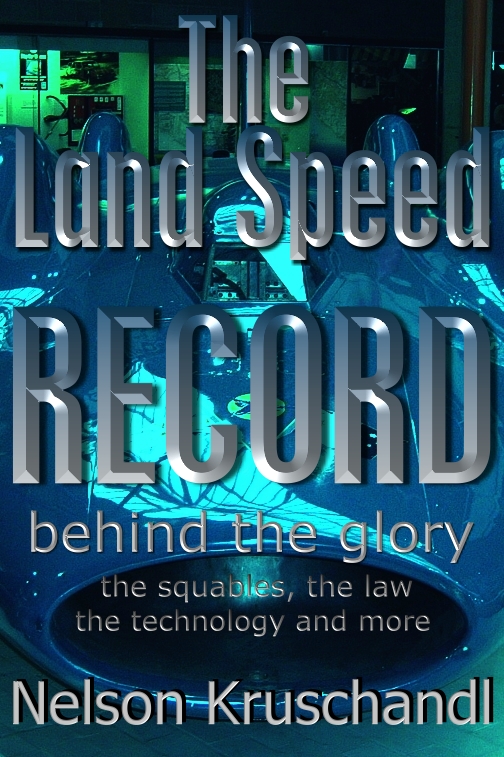
|


